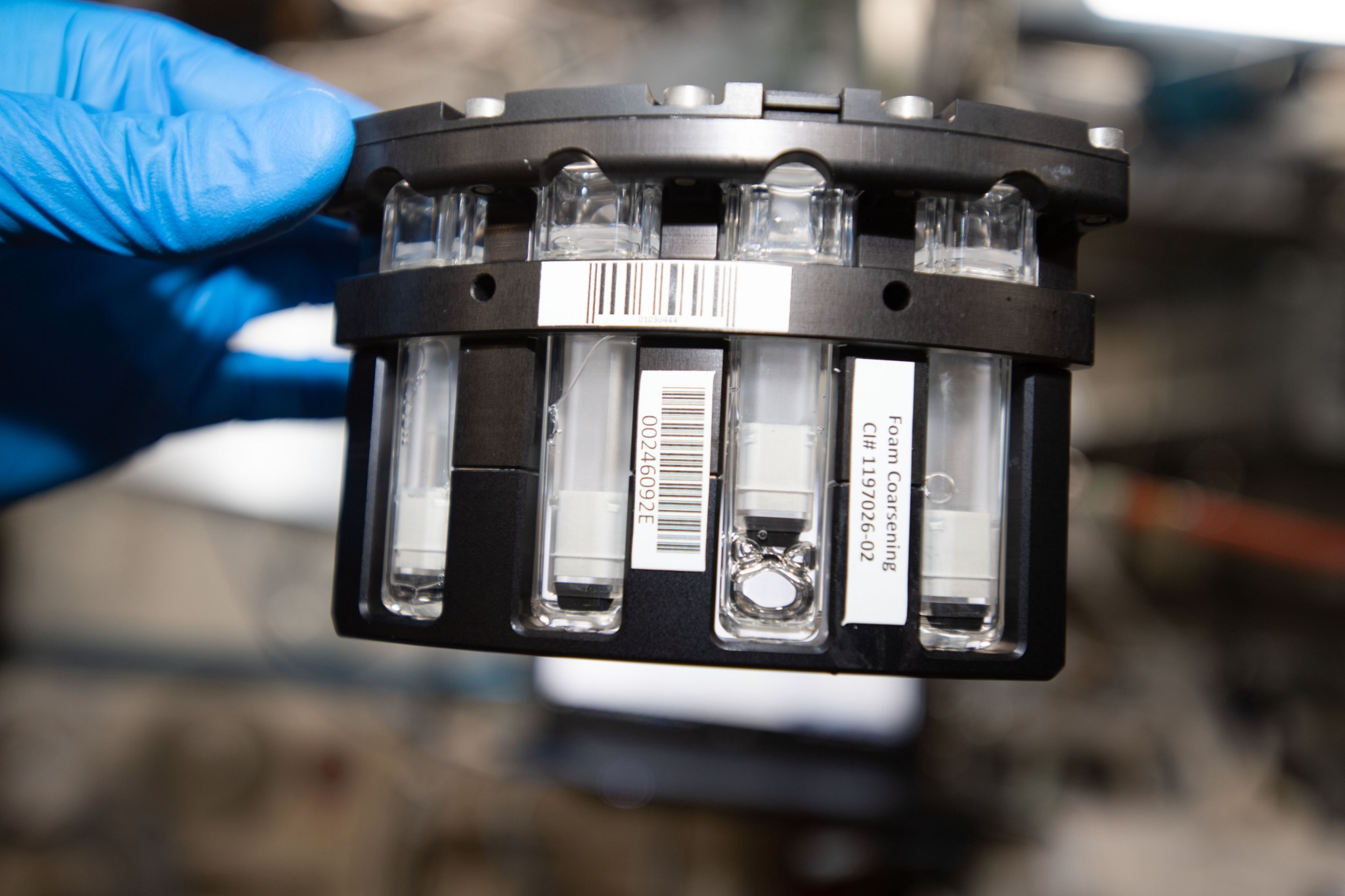[Lea la versión en español de este artículo]
Crew members aboard the International Space Station conducted scientific investigations during the week of Feb. 28 that included testing technology for processing glass fibers, examining the behavior of foams in microgravity, and characterizing biofilms in space.
The space station, continuously inhabited by humans for 21 years, has supported many scientific breakthroughs. A robust microgravity laboratory with dozens of research facilities and tools, the station supports investigations spanning every major scientific discipline, conveying benefits to future space exploration and advancing basic and applied research on Earth. The orbiting lab also provides a platform for a growing commercial presence in low-Earth orbit that includes research, satellite services, and in-space manufacturing.
Here are details on some of the microgravity investigations currently taking place:
Intelligent glass optics
Uniglo tests the effects of microgravity on a module for processing various types of complex glasses. The module uses artificial intelligence (AI) to adapt processing techniques to microgravity and a special sensor to measure how microgravity affects the processing. This investigation could help establish additional manufacturing capabilities in space. In addition, it could lead to development of novel fibers for optical communication and lasers with applications in planetary and space-based defense systems as well as space-based astronomical observations. Results also could advance design of complex glasses with potential applications in communications, aerospace, remote sensing, cutting and welding, and medical diagnostics and surgery on Earth. During the week, crew members gathered hardware, reviewed procedures, and initiated the experiment.
Focusing on foam
During the week, crew members installed the Soft Matter Dynamics (SMD) Experiment Container into the FSL Rack for Foam Coarsening. This investigation from ESA (European Space Agency) examines bubble size and rearrangement dynamics for wet foams. Dispersions of gas into liquid matrices, wet foams break down quickly on Earth, but are more stable in microgravity, enabling study of phenomena such as coarsening and coalescence. Potential space applications for foams include fighting fire, cleaning water, and making lightweight and resistant materials. Liquid foams also have a number of applications on Earth, including for detergents, food products, medicine, oil recovery, and firefighting. A better understanding of their properties could help improve design and processing for such uses.
A fungus among us
Space Biofilms characterizes the structure and gene expression of biofilms that form in space by analyzing a fungal species grown on different materials. Biofilm formation can cause equipment malfunction and human illnesses and could be a problem on future long-term human space missions. This investigation assesses the expression of genes associated with resistance to oxidative stress, acidity, and antimicrobials in the microorganisms and determines how they interact with different materials. Results could lead to improved methods and materials for controlling biofilm formation in space, helping to maintain the safety and performance of crewed spacecraft and the health and safety of crew members. This work also could help prevent the introduction of microbial life from Earth onto any planetary bodies on which humans land. Improved methods for controlling biofilm formation could help protect the health of people on the ground as well. Crew members removed samples from cold stowage and placed them into the Life Sciences Glovebox (LSG) to start the investigation.

Other investigations involving the crew:
- Colgate Skin Aging studies cellular and molecular changes in engineered human skin cells in microgravity. Results could show whether these engineered cells could provide a model for assessing products aimed at protecting skin from the aging process back on Earth.
- Acoustic Diagnostics, an investigation from ESA, tests the hearing of crew members before, during, and after flight to assess the possible adverse effects of noise on the space station and the microgravity environment on human hearing.
- SQuARE studies objects and built spaces and how crew members use them over time. Results could contribute to better design for future spacecraft and habitats.
- Astrobatics demonstrates a hopping or self-toss maneuver with the Astrobee robotic vehicles, which could serve as a means of propulsion using very little propellant. Such maneuvers could be incorporated into future robotic missions and advanced terrestrial robotic applications.
- ESA’s Retinal Diagnostics tests a commercially available lens that attaches to a mobile device to capture images of astronauts’ retinas. Such a lightweight, non-invasive imaging device could provide a way to detect Spaceflight Associated Neuro-ocular Syndrome (SANS) and help protect astronauts from its effects and also could be a useful telemedicine tool in space exploration and remote areas on Earth.
- Wireless Compose-2, an investigation from ESA, demonstrates a wireless network infrastructure for sensor monitoring and data transmission to support scientific experiments in microgravity.
- EasyMotion from ESA tests a suit worn during pre- and postflight exercise that provides Electro-Myo-Stimulation (EMS). It could save crew time and improve outcomes of inflight exercise on future space missions and in healthy populations on Earth.
- ISS Ham Radio provides students, teachers, parents, and others the opportunity to communicate with astronauts using amateur radio units. Before a scheduled call, students learn about the station, radio waves, and other topics, and prepare a list of questions on topics they have researched.
For daily updates, follow @ISS_Research, Space Station Research and Technology News or our Facebook. Follow ISS National Lab for information on its sponsored investigations. For opportunities to see the space station pass over your town, check out Spot the Station.
John Love, ISS Research Planning Integration Scientist
Expedition 66
























